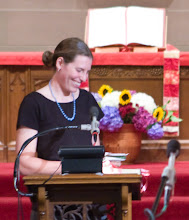(Cojack found Rob and Lee a couple years ago, and they still pet sit for him sometimes. To get the full effect of what it's like to live with a parrot, you must say "Hello," "Thank you," or "Go Cojack, go Cojack, go go" in a loud, raucous, nasally voice. Go ahead. Try it.)

Beyond the parrot, it's hard to describe the experience: the beaches of smooth rock worn by years, even centuries of tides coming in and going out; the mud flats revealed by the receding tide, a far cry from a sandy Gulf beach, and the seaweed as green as it is in seaweed salad from Ken's Sushi. The rhythm of the day is a rhythm of life that has never been conquered even by the most voracious human efforts to transcend. These rocks will be here long after any of us are, as will these waters and the islands in full rugged beauty. Existential anxiety set aside for a moment, there is a more holistic oneness here that minimalizes humanity's sense of entitlement to power, knowledge, even life. Indeed I see why people fall in love with this place.


Saturday was a trip to Deception Pass on the north side of Whidbey Island. It's history is intriguing; this from the Deception Pass State Park web site:
The human history of the park dates back thousands of years, when the first people settled in the areas now known as Cornet Bay, Bowman Bay and Rosario. Eventually, the land was settled by the Samish and the Swinomish. They lived on the land until the early 1900s. During his Northwest coastal explorations, Captain George Vancouver became the first
 European to identify the area near Whidbey Island as a passage, which he named "Deception Pass." A 1925 act of Congress designated the property for public recreation purposes. In the 1930s, the Civilian Conservation Corps (CCC) built roads, trails, buildings and bridges to develop the park. The name "Deception Pass" derived from Captain Vancouver's realization that what he had mistaken for a peninsula was actually an island. He named that island "Whidbey" in honor of his assistant, Joseph Whidbey, who was at his side when Vancouver realized the mistake. The captain named the inlet at which he was anchored "Deception Pass" to commemorate the error.
European to identify the area near Whidbey Island as a passage, which he named "Deception Pass." A 1925 act of Congress designated the property for public recreation purposes. In the 1930s, the Civilian Conservation Corps (CCC) built roads, trails, buildings and bridges to develop the park. The name "Deception Pass" derived from Captain Vancouver's realization that what he had mistaken for a peninsula was actually an island. He named that island "Whidbey" in honor of his assistant, Joseph Whidbey, who was at his side when Vancouver realized the mistake. The captain named the inlet at which he was anchored "Deception Pass" to commemorate the error. You can see even in the picture above how rapidly the water is moving as the tide rushes through the pass. When people serious about kayaking are learning how, I've heard they are brought here to deception pass to learn how to handle this kind of dangerous water. And it's not warm water either, even in the "heat" of summer. The bridge itself was dangerous enough for me, with my nervousness around high places. Here, rest assured, I certainly had sweaty palms and that slight lack of confidence in both the mechanical operation of my feet and the strength of the railing on the bridge.
You can see even in the picture above how rapidly the water is moving as the tide rushes through the pass. When people serious about kayaking are learning how, I've heard they are brought here to deception pass to learn how to handle this kind of dangerous water. And it's not warm water either, even in the "heat" of summer. The bridge itself was dangerous enough for me, with my nervousness around high places. Here, rest assured, I certainly had sweaty palms and that slight lack of confidence in both the mechanical operation of my feet and the strength of the railing on the bridge.The adventures of the weekend finished with a hike on Fidalgo Island. Douglas Fir trees were abundant, along with ferns and moss growing on the floor of the forest. It smelled like the rain forest exhibit in any zoo I've ever been to, the moisture that is trapped rarely to be touched by the sun's drying rays. Twice at lookouts we saw Bald Eagles soaring. From a distance I saw two things majestic in a different way, a rock quarry and a refinery. As it turns out even these wilds can be tamed. I suppose Seattle was once the same, overpopulated with Douglas Firs instead of people.
My attempt to create a map out of one of the pictures I took has failed, and so for now I will leave you with a picture of the cabin. Again and again as I'm here and have found new homes I am reminded of how place is a sacred and spiritual part of the way I move through the world.


No comments:
Post a Comment